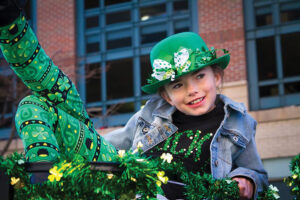 Back for first time since 2019 Early Parade Days How it all began.
Back for first time since 2019 Early Parade Days How it all began.
By Maureen Gargan-Caldwell
Denver St. Patrick’s Day Historian
How do you begin to tell the story of one of Denver’s finest community events since 1889? Many argue that the parade has become the single largest gathering of Colorado residents every year in one place, where everyone sets aside their own heritage to become Irish for a day. Many people are under the misconception that the parade is organized and presented by the City of Denver every year. The parade is actually organized and driven by a group of volunteers officially incorporated in 1986 as the Denver St Patrick’s Day Parade Committee, Inc.
The committee is a charitable organization with each and every one of its members devoted volunteers. Each member has a deep love for the Irish culture and enjoys sharing that sense of pride with the entire Denver community with year-round efforts, culminating with the parade-day event. Original St. Patrick’s Day Parade
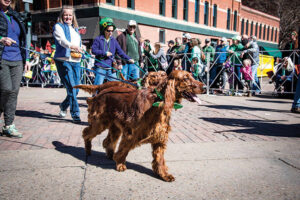 The St. Patrick’s Day Parade in Denver actually dates back to 1889 when Denver held its very first St Patrick’s Day Parade. As was the tradition at that time Division 1 of the Ancient Order of Hibernians kicked off the celebrations with a Grand Ball the night before the parade. It was held at the then Special Hall at the Denver Chamber of Commerce and was lit entirely by gas lamps. The Rocky Mountain News covered the Grand Ball as well as the parade and reported the Grand Ball was “the most prominent and pleasing social event in the city” with “hundreds of couples dancing the night away.”
The St. Patrick’s Day Parade in Denver actually dates back to 1889 when Denver held its very first St Patrick’s Day Parade. As was the tradition at that time Division 1 of the Ancient Order of Hibernians kicked off the celebrations with a Grand Ball the night before the parade. It was held at the then Special Hall at the Denver Chamber of Commerce and was lit entirely by gas lamps. The Rocky Mountain News covered the Grand Ball as well as the parade and reported the Grand Ball was “the most prominent and pleasing social event in the city” with “hundreds of couples dancing the night away.” The parade began the next morning at 9:15 and was led by Grand Marshal Frank McGuire. Actual numbers were not recorded, but the parade itself consisted of two divisions of several Irish groups including the Ancient Order of Hibernians with some groups numbering close to one hundred. The parade finished in time for all to attend high Mass at St Elizabeth’s Church.
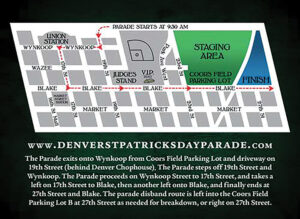 Parades in Denver continued from 1889 through 1921 with the same route: starting at Fourteen Street and Lawrence, down Fourteenth Street to Colfax Avenue, to South Fourteenth Street over to Broadway, with a trip in front of the Capitol and eventually working itself back to Fourteenth and Larimer Streets. In 1902, the Ancient Order of Hibernians held their national convention in July and utilized all of their funds for the convention (where over 3,000 were in attendance). The parade was canceled that year for purely economic reasons, but a large, well-attended Ball at the Denver Coliseum had a thirty piece orchestra with a planned set of over 24 dances. From 1907 until 1920 the combination of the parade and the Ball were the largest social events of the City of Denver and surrounding regions.
Parades in Denver continued from 1889 through 1921 with the same route: starting at Fourteen Street and Lawrence, down Fourteenth Street to Colfax Avenue, to South Fourteenth Street over to Broadway, with a trip in front of the Capitol and eventually working itself back to Fourteenth and Larimer Streets. In 1902, the Ancient Order of Hibernians held their national convention in July and utilized all of their funds for the convention (where over 3,000 were in attendance). The parade was canceled that year for purely economic reasons, but a large, well-attended Ball at the Denver Coliseum had a thirty piece orchestra with a planned set of over 24 dances. From 1907 until 1920 the combination of the parade and the Ball were the largest social events of the City of Denver and surrounding regions.
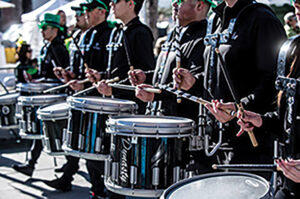 The 1960’s
The 1960’s It was not until the early 1960s that the parade re-emerged. There are many accounts of what actually happened. This history includes the common elements of each pulled from the Denver Post, Rocky Mountain News, handwritten accounts and interviews. One account has the beginnings of the Parade in 1962 at “Sullivan’s Grill” at 14th and Glenarm Pl. where three men, Pocky Marranzino, columnist, Rocky Mountain News, Red Fenwick, columnist Denver Post and Jim Eakins, parole officer, Denver met regularly. Their favorite stools were at the end of the bar with a clear view of the front door so they could meet and greet their many friends entering. The three had planned to do something this special night of March 17, 1962. After a few drinks, each one of them pulled out a small American flag and all three rose, headed out the door to the middle of the street where they formed a single line and marched around the block. Everyone in Sullivan’s came out and cheered the three on (as told by Pocky Marranzino to Lynn LaGrange).
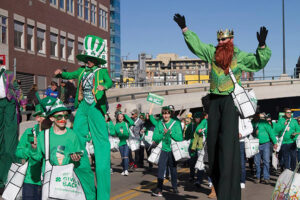 Another popular account (as documented by Denver Post columnist Tom Noel) has the beginning of the Parade in 1962 this time in Duffy’s Tavern. The place was called Duffy’s Shamrock Bar, Irish Coffee House and Restaurant. At Duffy’s a group of mostly Denver Post journalists met regularly for drinks; they called themselves the “Evil Companions Club.” In 1962 the “Evil Companions” with help of the tavern owners convinced Adolph Coors Company into greening the beer for St. Patrick’s Day. Holding a single small American flag, the three left the bar and marched around the block to cheers of many bystanders. Even Tom Noel admits there are various accounts of the beginnings of the parade and his is just one.
Another popular account (as documented by Denver Post columnist Tom Noel) has the beginning of the Parade in 1962 this time in Duffy’s Tavern. The place was called Duffy’s Shamrock Bar, Irish Coffee House and Restaurant. At Duffy’s a group of mostly Denver Post journalists met regularly for drinks; they called themselves the “Evil Companions Club.” In 1962 the “Evil Companions” with help of the tavern owners convinced Adolph Coors Company into greening the beer for St. Patrick’s Day. Holding a single small American flag, the three left the bar and marched around the block to cheers of many bystanders. Even Tom Noel admits there are various accounts of the beginnings of the parade and his is just one. Most accounts agree that the idea of an “official parade” came to fruition in 1962 with the visit of the Lord Mayor of Dublin, Robert Briscoe. This year the parade was held on April 17 because of the visit to Denver from Dublin’s Lord Mayor Robert Briscoe. His honor dined at Duffy’s with the Irish American contingent that knew or heard of the visit. The Lord Mayor Robert Briscoe of Dublin was met at 8:30am at Stapleton Airport, Denver, by a welcoming committee consisting of Lt Gov. Robert Knous and Bernard Duffy, proprietor of Duffy’s Shamrock Tavern and Irish Coffee House. Upon his arrival he was driven in a motorcade to the Brown Palace Hotel where he met with business and industry leaders to promote Irish products and industry. Most accounts agree that the inspiration that got the parade restarted in 1963 as an official event was the visit of the Lord Mayor. After the meeting a large group piled into Duffy’s Shamrock Restaurant Bar at 1635 Court Street where the group lamented the deceased parade that had once been the hallmark social event for Denver until 1920. The group talked about organizing for an official parade in 1963.
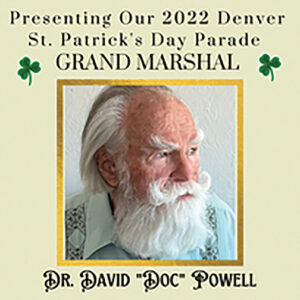 Official Parade Chairman
Official Parade Chairman In 1963, Louis Walsh, a state revenue department auditor and head of the Irish Fellowship Club, was delegated to find a chairman for an official parade. Committee member Charlie Gallagher assumed the task immediately. While riding the elevator at work in the State House, Charlie asked someone what he thought of the parade idea. “Not much” the individual replied, “the last parade participants from the YMCA were stoned by the Masons. However, if you are still interested in that stuff, call my son, Jim Eakins, who is with the Interstate Probation and Parole Dept. and runs the Flag Day Parade for the American Legion.” Walsh’s friend Jim Eakins had been staging parades for the American Legion since 1956 so he was the logical choice. Eakins hit the phone and started calling his Legion friends and about a dozen decided to help out. Many meetings were held in Duffy’s bar and some of the regulars included, Bob Hart, Joe McGoey (part owner and VP of Duffy’s Delicious Drinks), Elmer Tintera (from N.C.R.). The Parade Committee was officially formed and Denver held its first “official” St. Patrick’s Day Parade since the early 1920s. There were 70 floats and marching units in the parade that year and despite the unusually high winds that day the streets were lined with spectators.
Early on, Eakins formed a group called “The Wearers of the Green” and printed and sold membership cards for $2.00 each in order to raise seed money for the venture. The first Parade Grand Marshal was Michael O’Moran from Ireland. Mr. O’Moran was the Minister of Lands and brother to parade founder, John Moran. From these early days through the 1990s the Denver Black Thorn Society (including many of the founders of the Parade) led the other entries through the streets of Denver. A delegation of Irish leaders headed by Bernard Duffy and Mayor Dick Ballerton traveled to Cheyenne, Wyoming to invite Mayor Bill Nation to participate.
The First Unofficial Parade
The first unofficial parade in 1962 was chartered by 15 men. Some were very prominent business men, as John T. “Jack” Horan recounted during the 28th Annual Queen Colleen Coronation Ball:
“Three of the charter members are here tonight: Eddie Day, Retired Chief Justice of the Colorado Supreme Court. Tom Gargan, Retired Blue Cross Executive; Eddy Smith, still active in banking and the first Treasurer of the Parade Committee. Other Charter members included Jim Eakins, Don Bower, Bob Hart, Charlie O’Brien and Nick Frangos. During this time there has been one lady involved in all of our work, our backbone Marie Eakins.”
The Irish Fellowship Club, and its growing number of members played a key role in organizing the parade. Under the leadership of Jim Eakins, members Sally O’Connor, Margaret Donavan, Dolores Leahy, Kitty Heffernan, Joyce Carter, Mary Feeny and Dorothy Conley and many others were in charge of the decorations, secretarial work, fundraising and whatever it took to have a successful parade.
The First Official Parade
In the first official parade, Miss Evelyn Maher was our first Queen. From 1963 to 1965 the Parade crowned their own Queen, titled “Queen of the Emerald Isle.” The coronation ball was one of Denver’s largest social events. In 1965 the Parade Committee changed the name of the Queen to “Queen Colleen.” Many bands participated in 1963 including the Gold Sash Band, Highlanders Boys’ Bands, Centennial Grenadiers, the American Legion Post 1 and bands from all divisions of the armed forces.
While our official origins start in 1962, in 1963 the founders applied for a permit for an official parade on 17 March—with official parade entries and actual advertisement of the parade. There were about 5,000 people on hand to watch the parade, in what was described as one of the worst windstorms in years. There were over 70 marching units this first year and invitations to the parade went out to the mayors of 53 towns and cities in Colorado. The high winds caused the parade to be cut in half, marking only 12 blocks instead of the planned 24. The winds were so bad that many store front windows were broken out causing the parade route to move from 16th street to a route that lead from 15th St. to Tremont Pl, across to 17th St. to Lincoln St. and then south on 14th St. where the parade ended. The parade lasted an hour and Jim Eakins, the first Parade Chairman, said, “Everyone was pleased, It was an unqualified success. We’ll be back next year.” One of the most impressive entries was the Denver Police Department’s K-9 Corps. The Festivities concluded with a gala at St. Patrick’s Day Charity Ball held at the Cosmopolitan Hotel.
Today’s Parade
This was the start of our Parade as we know it today. As we look forward to the next 58 years, let us remember what Jim Eakins and the early Charter members would always say, “This is a Parade, let’s make it fun!”
The History Committee would like to thank all the many members that contributed to the compilation of our history. This compilation came from personal written accounts from members such as Jack Horan, Vincent Walsh, Lynn LaGrange, Jim Eakins and Tom Gargan. Many of the details were researched by Louann Eakins Nelson, “Sam” Kerwin, Shelia Gargan, Pat Halpin, and Tom Quinn. Thousands of articles and pictures were submitted by members that helped us pull together this history—we wish to thank you all.















Follow Us